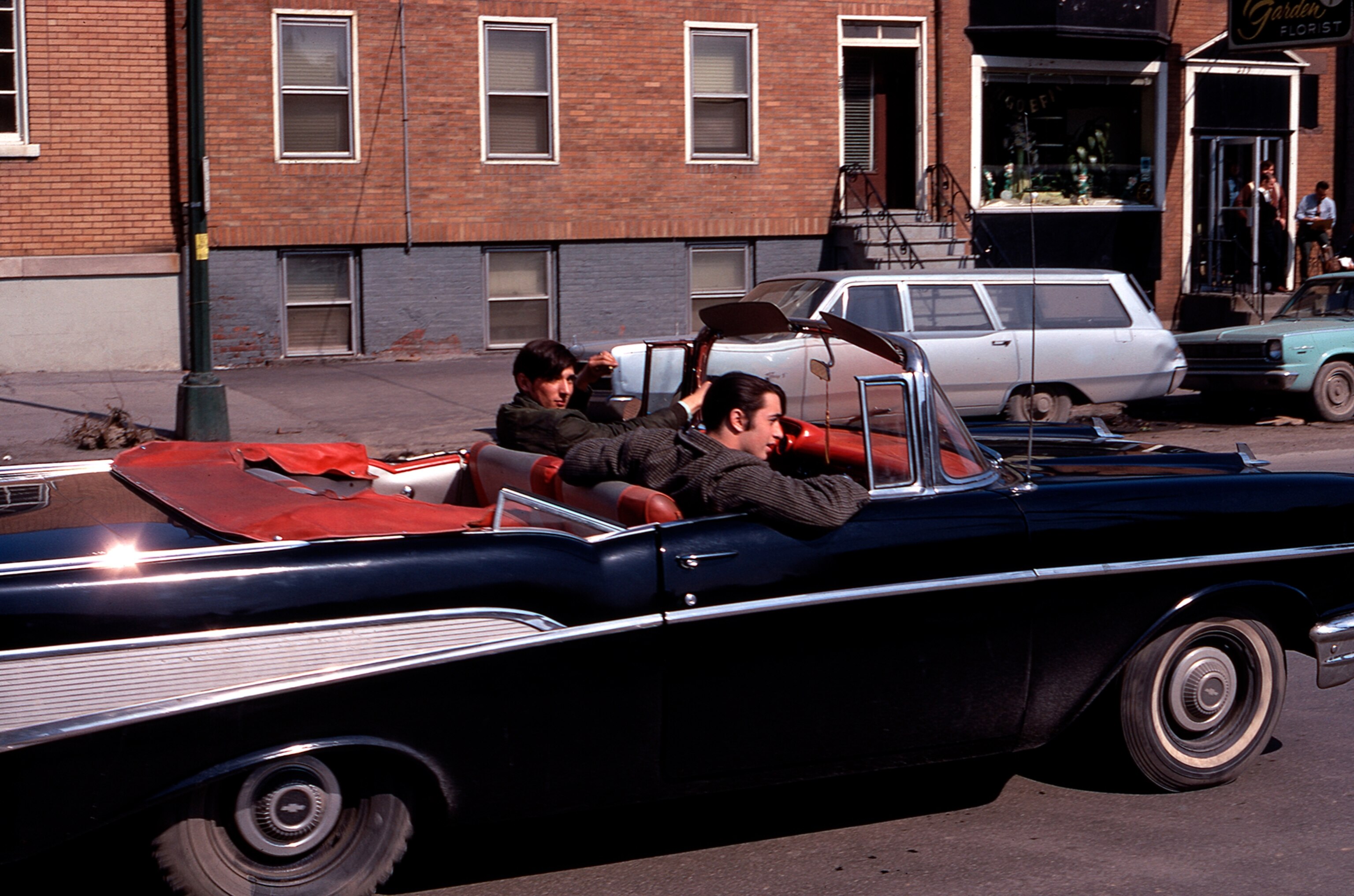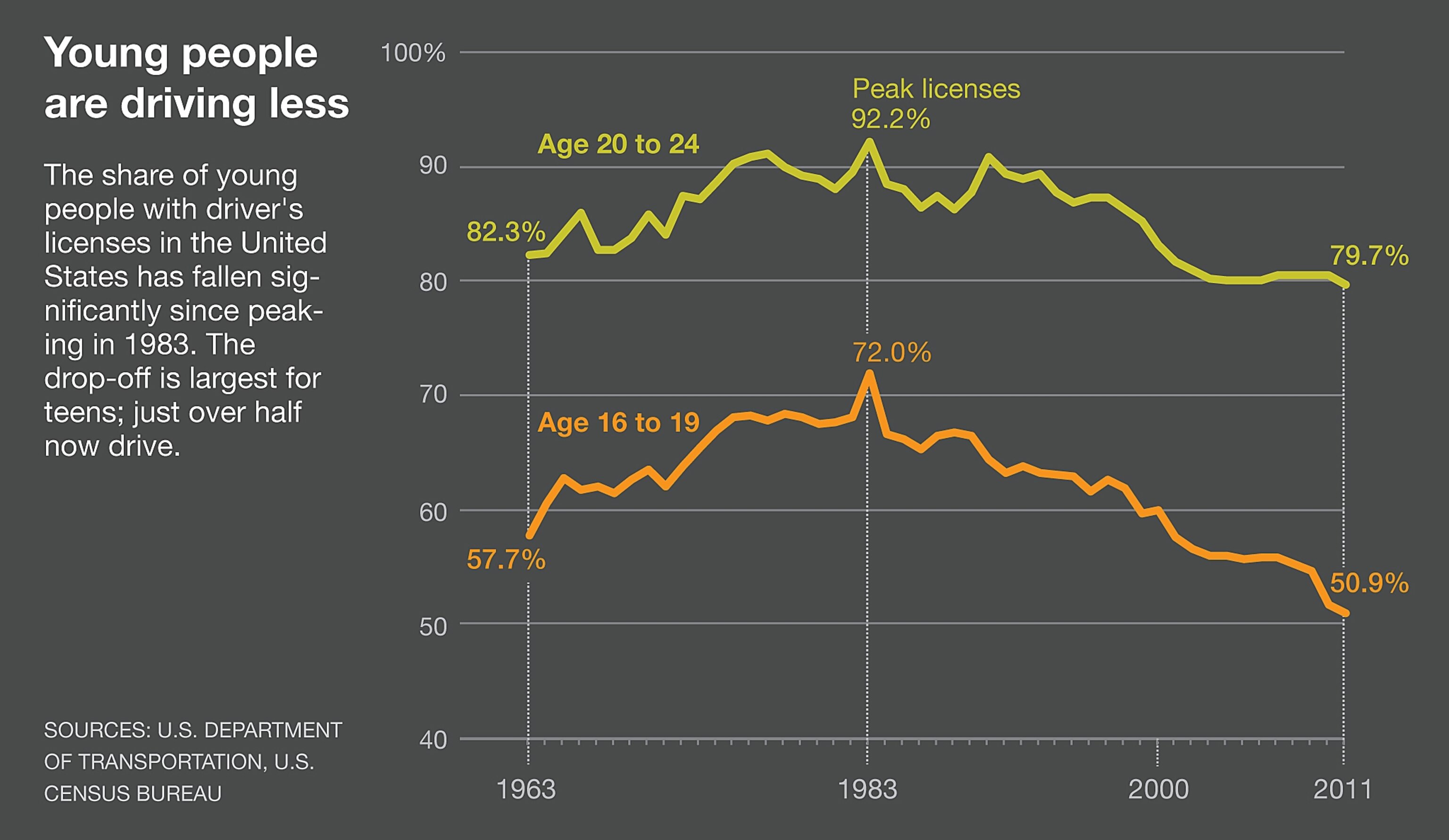
U.S. Teenagers Are Driving Much Less: 4 Theories About Why
EIA sees slower growth in U.S. miles traveled as more teens shun licenses.
Throw a sheet over the little deuce coupe, park the little red Corvette, and send the pink Cadillac to the ranch.
U.S. teenagers just aren't as into driving as they used to be, U.S. government forecasters acknowledged Monday in dramatically altered projections for transportation energy use over the next 25 years. (Take the related quiz: What You Don't Know About Cars and Fuel.)
Growth in "vehicle-miles traveled" (VMT)—that key gauge of America's love affair with the automobile that once reliably ratcheted up year after year—will slow dramatically, the U.S. Energy Information Administration (EIA) says in its new Annual Energy Outlook. The EIA slashed its projected annual VMT growth rate to 0.9 percent, a drop of 25 percent compared to its forecast only a year ago.
The change is partly due to slower population growth, but also because of a generational shift confirmed by at least four studies in the past year. In the United States, young people are not only driving less than teens did a generation ago, they aren't even getting licenses.

Put that demographic trend together with the dramatic increase in fuel economy expected in the years ahead, and U.S. energy consumption to fuel cars is expected to drop one-quarter to 12.1 quadrillion Btu by 2040. (See related, "Pictures: A Rare Look Inside Carmakers' Drive for 55.")
It sounds like good news for everyone except carmakers and songwriters, but the figures have stirred ferocious debate among numbers-crunchers. Is indifference to motoring, like so many other youth trends, a passing phase? Or have we finally erased the last traces of American Graffiti and the car-centric teen culture that once celebrated cruising, hot-rodding, and drive-ins? (See related, "Pictures: Cars That Fired Our Love-Hate Relationship With Fuel.")
These are more than academic questions, since they affect a huge chunk of the economy. U.S. energy and transportation forecasters plan to look more deeply into the reasons behind the trends, but here are the key theories that have been aired so far.
With "Virtual" Access, No Need for Wheels
Researchers at the University of Michigan's Transportation Research Institute (UMTRI) note that the percentage of young drivers is inversely related to the proportion of Internet users. Social media may be taking the place of motorized transportation, they theorize.
"Virtual contact, through electronic means, reduces the need for actual contact," said Michael Sivak, a research professor in UMTRI's human factors group. Bolstering this theory is international data the Michigan researchers compiled showing that in countries around the world, a higher proportion of Internet users was associated with lower rates of licensed young drivers.
Seven countries, including Canada, South Korea, Germany, and Japan, are seeing similar shifts in the demographics of licensed drivers. (See related, "Driving the Limit: Wealthy Nations Maxed Out on Travel?")
In the United States, the Michigan team found that the percentage of 19-year-olds with driver's licenses fell from 87 percent to 70 percent between 1983 and 2010. For 17-year-olds, the fall was even more dramatic, from 69 percent in 1983 to 46 percent by 2010.
Times Are Too Tough for Teen Driving
The insurance industry's research arm, the Highway Loss Data Institute (HLDI), pointedly disputes the "virtual access" theory. Its analysis of U.S. collision insurance policies confirms the trend, showing a 12 percent drop in covered teen drivers just since 2006. But HLDI said the fall-off tracked with an increase in unemployment that was steeper among teens than for the general population of drivers. "It looks like teens just can't afford to drive," said HLDI Vice President Matt Moore. "Paying for their own cars, gas, and insurance is hard if they can't find a job."
Scientists with the Centers for Disease Control also cited economic factors in their analysis of the downward trend in teen driving.
Moore argued the trend may be transitory. "As the economy picks up again, it's possible that more teenagers will get behind the wheel," Moore said. "Unfortunately, that may also mean a rise in teen crash fatalities, which have been trending downward."
It's a Matter of Choice
But the nonprofit U.S. Public Interest Research Group (PIRG) argues that something fundamental has changed in how young people feel about cars. "Many members of Generation Y have reduced their driving because they choose to take transportation alternatives instead of cars to school, work, and recreation, and because many have chosen to live in ways that require less time behind the wheel of a car," PIRG said in a report compiling a number of polls that support the theory. PIRG followed up with a report on the overall downward trend in U.S. driving, showing that cities with the biggest drops in driving had no greater unemployment than cities with smaller declines. (See related, "Car Sharing Widens Lanes of Access for City Drivers.")
Said PIRG, "Growing evidence—both anecdotal and quantitative—suggests that some of this change is being driven by shifts in young people's priorities and preferences, shifts that could very well persist as Generation Y ages." (Related: "Bike Share Schemes Shift Into High Gear")
They Just Haven't Gotten Around to It
But only 9 percent of young nondrivers cited concern over how driving affects the environment as their reason for putting off getting a license, a survey by the Michigan researchers found. The top reason for putting off getting a license, cited by 37 percent of respondents, was far less lofty: "too busy or not enough time to get a driver's license."
Among the other (primary or secondary) reasons cited was something to support almost any of the competing theories: 32 percent said owning and maintaining a vehicle was too expensive, 31 percent said they were able to get transportation from others, 22 percent said they preferred to bike or walk, and 17 percent said they preferred public transit.
Twenty-two percent of the young nondrivers said they never planned on getting a driver's license—a minority, but one researchers will be trying to understand better in the years ahead. (Related: "Supercomputing Power Could Pave the Way to Energy-Efficient Engines")
This story is part of a special series that explores energy issues. For more, visit The Great Energy Challenge.








